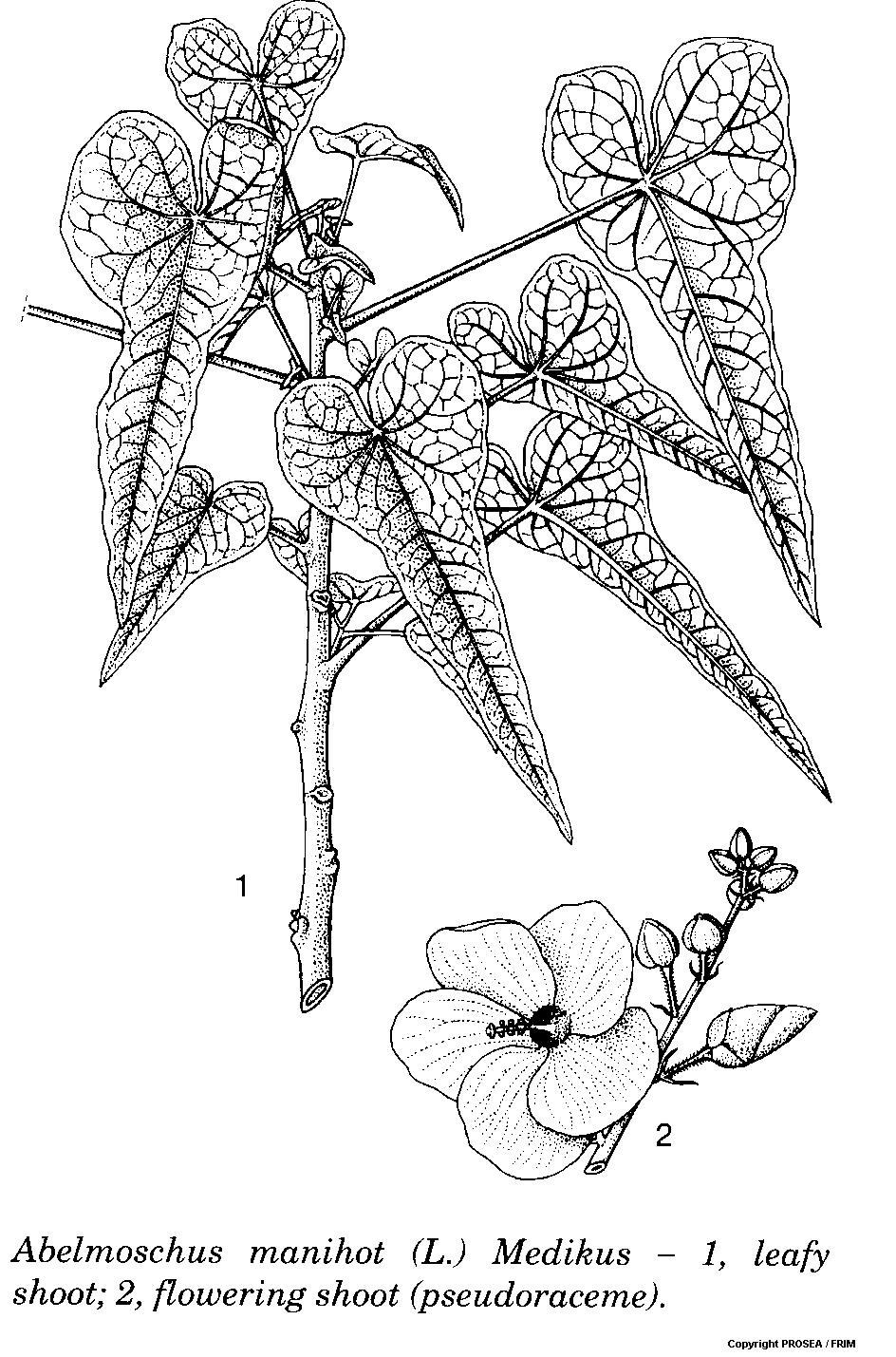Scientific Name
Abelmoschus manihot (L.) Medik.
Synonyms
Abelmoschus caillei (A.Chev.) Stevels, Abelmoschus platidactylus (Bakh.) Nakai, Abelmoschus pseudomanihot (DC.) Endl., Hibiscus japonicus Miq., Hibiscus manihot L [1].
Vernacular Name
Scientific Classification
| English | Aibika (Pidgin); sunset hibiscus, manioc-hibiscus, sunset muskmallow [2] [3] |
| Indonesia | Gedi (Minahasa); degi (Ternate) [2] |
| Philippines | Lagikuway (Tagalog); barakue (Batanes); glikway (Subanon) [2] |
| Thailand | Po-fai (Northern) [2] |
| Germany | Maniok-bisameibisch [3] |
| Sweden | Solokra [3] |
| Fiji | Bele, mbele [3] |
| Sweden | Solokra [3] |
| Papua New Guinea | Aibika [2] [3] |
| Portugese | Quiabo-bravo, Quiabo-de-jardim [4] |
| Superkingdom | Eukaryota |
| Kingdom | Plantae |
| Phylum | Tracheophyta |
| Subphylum | Spermatophytina |
| Class | Magnoliopsida |
| Order | Malvales |
| Family | Malvaceae |
| Genus | Abelmoschus |
| Species | manihot |
| Binomial Name | Abelmoschus manihot |
Geographical Distributions
Abelmoschus manihot is a cultigen with a wide distribution. It grows over a wide range of climates but in the tropics it mainly occurs from the lowlands to 1200 m altitude. However, at high elevations, growth is slower. This plant is a popular traditional vegetable in Melanesia, but has also been introduced into other continents, either as a vegetable or as an ornamental (sunset ‘hibiscus’). In Southeast Asia it is cultivated particularly in the eastern parts of Indonesia and in Papua New Guinea. [2]
Botanical Description
A. manihot is agenus from Malvaceae family. It is a perennial shrub that can grow 1-3(-7) m tall. [2]
The stem is an erect, woody, branching and hairless or pubescent (without prickly hairs unlike related wild forms). [2]
The leaves are simple, arranged alternate, extremely variable in shape, size, colour and pigmentation (or marking). The leaf-blade is linear, lance-shaped, cordate or deeply lobed or parted with 3-7 segments and with varied colours from light to dark green through red to purple. Petiole is 3-25 cm long and with slender or lance-shaped stipules. [2]
The flowers are large, bell-shaped, measure 7-15 cm in diametre, axillary, solitary or in racemes by the reduction or abortion of the upper leaves. The pedicel is 1-5(-7) cm long. The epicalyx segments are 4-6(-8), free, ovate to oblong in shape and with a size measuring 1-3 cm x 0.5-1 cm. The sepal is spathaceous, measuring 2-3 cm long, splits on one side during the expansion of the petal, adnate to and falls with the petal. The corolla consists of 5 large and obovate to orbicular petals. They measure 3-8 cm in diametre, pale yellow with the central spot dark brown or reddish in colour. The ovary is superior and 5-celled. The style is surrounded by the staminal column from which it emerges and divides into 5 lobes where each lobe ends in a flattened, disk-shaped and dark brown stigma. The staminal column measure up to 3 cm long, white, bear numerous filaments and anthers. [2]
The fruit is an oblong-ovoid capsule, measuring 3.5-6 cm x 2-2.5 cm, hairy, usually 5-angled and splits into 5 segments. [2]
The seeds are numerous, spherical to kidney-shaped, 2-4 mm in diametre and black in colour. [2]
The root system is usually adventitious and fairly shallow with most of the roots in the top 30-40 cm of the soil. [2]
Cultivation
A. manihot requires well-distributed rainfall of at least 1200 mm/year for good production. A. manihot is sensitive to waterlogging and prefers well-drained loams with a pH of 5.5-7, but grows on a wide range of soils. Little is known about the eco-physiology of A. manihot, but there are indications that it behaves as a qualitative short-day plant. In Port Moresby (9°S), A. manihot flowers between July and November. [2]
Chemical Constituent
No documentation
Plant Part Used
No documentation
Traditional Use
No documentation
Preclinical Data
No documentation
Clinical Data
No documentation
Poisonous Management
No documentation.
Line Drawing

References
-
The Plant List. Abelmoschus manihot (L.) Medik. 2013 ver1.1 [updated 2013, cited 2014 July 8] Available from: http://www.theplantlist.org/tpl1.1/record/kew-2609589
- Siemonsma JS, Piluek K. Abelmoschus manihot (L.) Medik. Plant Resources of South-East Asia No. 8: Vegetables. The Netherlands, Pudoc Scientific Publishers; 1993. p. 60–62.
- Germplasm Resources Information Network (GRIN). Taxon: Abelmoschus manihot (L.) Medik. [updated 2014 June 30; cited 2017 July 1]. Available from: http://www.ars-grin.gov/cgi-bin/npgs/html/taxon.pl?621
- Global Biodiversity Information Facility (GBIF). Species: Abelmoschus manihot (L.) Medik. [updated 2021; cited 6 May 2022]. Available from: https://www.gbif.org/species/3152706]


